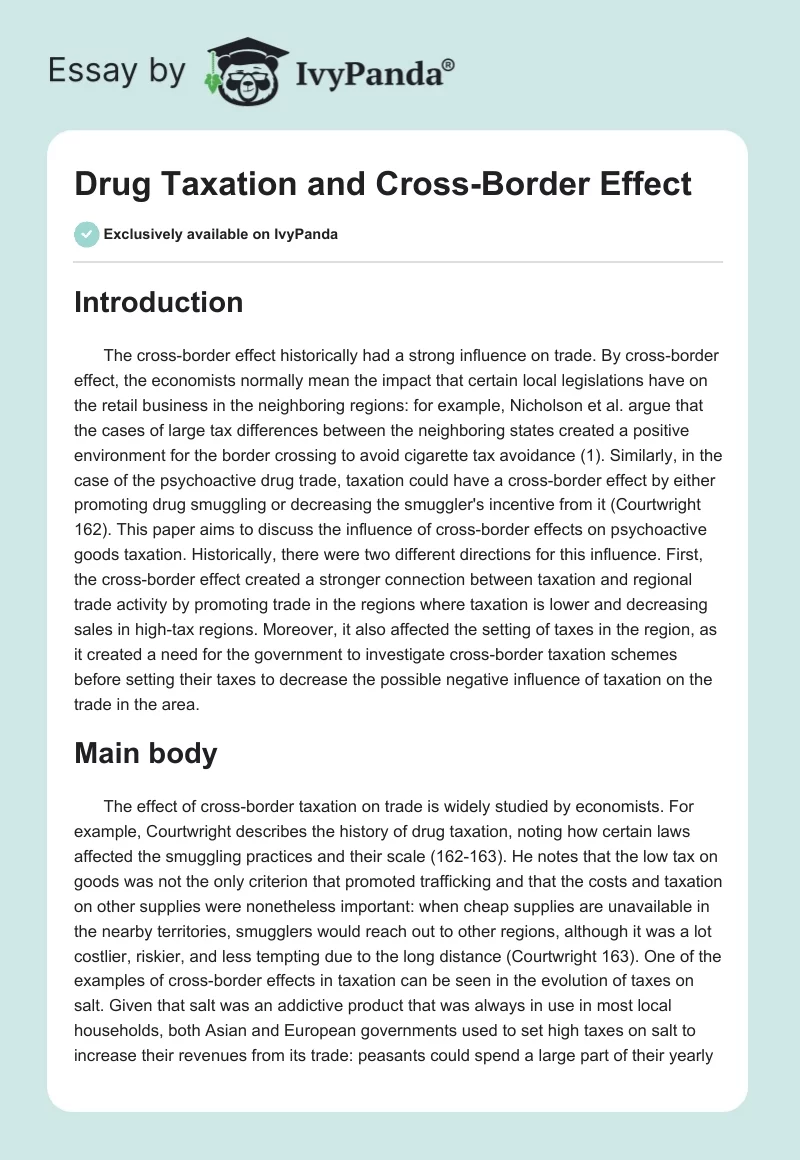Introduction
The cross-border effect historically had a strong influence on trade. By cross-border effect, the economists normally mean the impact that certain local legislations have on the retail business in the neighboring regions: for example, Nicholson et al. argue that the cases of large tax differences between the neighboring states created a positive environment for the border crossing to avoid cigarette tax avoidance (1). Similarly, in the case of the psychoactive drug trade, taxation could have a cross-border effect by either promoting drug smuggling or decreasing the smuggler’s incentive from it (Courtwright 162). This paper aims to discuss the influence of cross-border effects on psychoactive goods taxation. Historically, there were two different directions for this influence. First, the cross-border effect created a stronger connection between taxation and regional trade activity by promoting trade in the regions where taxation is lower and decreasing sales in high-tax regions. Moreover, it also affected the setting of taxes in the region, as it created a need for the government to investigate cross-border taxation schemes before setting their taxes to decrease the possible negative influence of taxation on the trade in the area.
Main body
The effect of cross-border taxation on trade is widely studied by economists. For example, Courtwright describes the history of drug taxation, noting how certain laws affected the smuggling practices and their scale (162-163). He notes that the low tax on goods was not the only criterion that promoted trafficking and that the costs and taxation on other supplies were nonetheless important: when cheap supplies are unavailable in the nearby territories, smugglers would reach out to other regions, although it was a lot costlier, riskier, and less tempting due to the long distance (Courtwright 163). One of the examples of cross-border effects in taxation can be seen in the evolution of taxes on salt. Given that salt was an addictive product that was always in use in most local households, both Asian and European governments used to set high taxes on salt to increase their revenues from its trade: peasants could spend a large part of their yearly income on salt, with most of the price representing the government’s tax (Courtwright 163). Nevertheless, illegal smuggling of salt arose in response to high taxes; smugglers used to bring salt from low-tax regions to high-tax areas to sell it to people at a more favorable price (Courtwright 163). Another example of how taxation facilitated cross-border trade is the case of tobacco sales in the 1960s-1970s. Courtwright explains that cigarette taxation was highly uneven, which caused an increase in tobacco trade in the states with lower taxes, such as North Carolina (163). The states where taxation was increasingly high, such as New York, on the other hand, suffered severe losses of revenues from tobacco taxes: by the mid-1970s, net losses of revenue could reach over 300 million dollars a year (Courtwright 163), much of which went to criminals and smugglers. As a result of revenue losses due to smuggling, some governments had to decrease tobacco taxes, thus proving the impact of the cross-border effect on taxation.
Another way that cross-border effect influenced taxation was by promoting cross-border cooperation. For example, Courtwright states that, in thinking how high they could safely push their taxes, the government officials had to be aware of the taxation set by their neighbors (163). Both in the salt example and the case with the tobacco trade, loss of tax revenues could be avoided if an even cross-border taxation approach was used from the very beginning. Thus, when the taxation on salt was determined, both the Chinese and European governments could compare the tax rates of the neighboring regions and adjust their planned figures for better cross-border tax cooperation. Similarly, tobacco taxes required a well-rounded unified approach to be implemented in all states at once to even out the tax revenues, as both smuggling and adjustment behavior of customers could lead to the loss of revenue due to the reduction of cigarette tax collections and the decrease in sales of cigarette products (Nicholson et al. 2). A more unified approach for all states would result in even tax revenues from the sale of tobacco not just in the U.S., but all over the world (Courtwright 164).
Finally, the cross-border effect was also used to determine the effective level of taxation. Similar to cross-border cooperation, this was caused by the need to avoid loss of revenues due to high tax levels. However, the cross-border effect was also utilized in countries that wanted to raise their tax revenues by promoting trade. For instance, in Mexico, the price of supplies needed for the drug trade, as well as the cost of drugs, has been relatively small compared to that of the U.S. in the late 20th century, which promoted the trade in the region.
Conclusion
Overall, the history of taxation and trade shows that the cross-border effect was one of the determining factors of effective taxation levels, as it facilitated the connection between taxation and trade intensity. Therefore, by looking at the taxation levels imposed on psychoactive goods in the neighboring regions, as well as globally, governments could either define the effective level of taxation that would answer to the external tax levels or propose lower taxes to facilitate trade activities.
Works Cited
Courtwright, David T. Forces of Habit: Drugs and the Making of the Modern World. Harvard University Press, 2002.
Nicholson, Andrew, et al. “Cigarette Taxes and Cross-border Revenue Effects: Evidence Using Retail Data.” Public Finance Review, vol, 44, no. 3, 2016, pp. 1-33.


